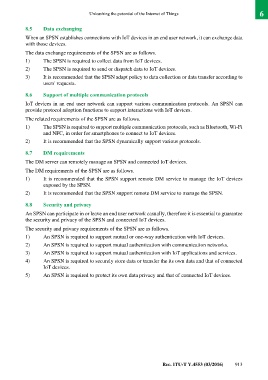Page 927 - Unleashing the potenti al of the Internet of Things
P. 927
Unleashing the potential of the Internet of Things 6
8.5 Data exchanging
When an SPSN establishes connections with IoT devices in an end user network, it can exchange data
with those devices.
The data exchange requirements of the SPSN are as follows.
1) The SPSN is required to collect data from IoT devices.
2) The SPSN is required to send or dispatch data to IoT devices.
3) It is recommended that the SPSN adapt policy to data collection or data transfer according to
users' requests.
8.6 Support of multiple communication protocols
IoT devices in an end user network can support various communication protocols. An SPSN can
provide protocol adoption functions to support interactions with IoT devices.
The related requirements of the SPSN are as follows.
1) The SPSN is required to support multiple communication protocols, such as Bluetooth, Wi-Fi
and NFC, in order for smartphones to connect to IoT devices.
2) It is recommended that the SPSN dynamically support various protocols.
8.7 DM requirements
The DM server can remotely manage an SPSN and connected IoT devices.
The DM requirements of the SPSN are as follows.
1) It is recommended that the SPSN support remote DM service to manage the IoT devices
exposed by the SPSN.
2) It is recommended that the SPSN support remote DM service to manage the SPSN.
8.8 Security and privacy
An SPSN can participate in or leave an end user network casually, therefore it is essential to guarantee
the security and privacy of the SPSN and connected IoT devices.
The security and privacy requirements of the SPSN are as follows.
1) An SPSN is required to support mutual or one-way authentication with IoT devices.
2) An SPSN is required to support mutual authentication with communication networks.
3) An SPSN is required to support mutual authentication with IoT applications and services.
4) An SPSN is required to securely store data or transfer the its own data and that of connected
IoT devices.
5) An SPSN is required to protect its own data privacy and that of connected IoT devices.
Rec. ITU-T Y.4553 (03/2016) 913

